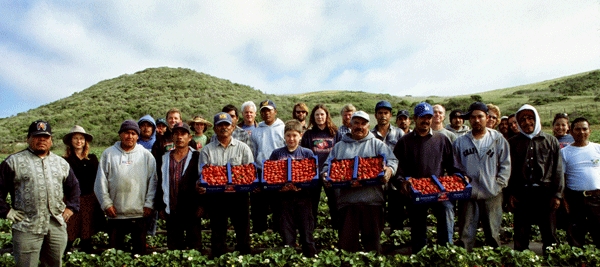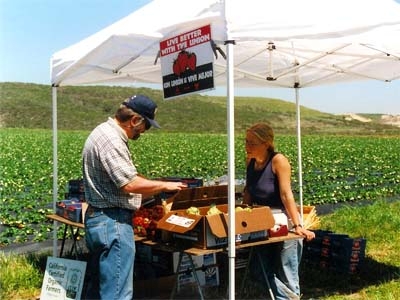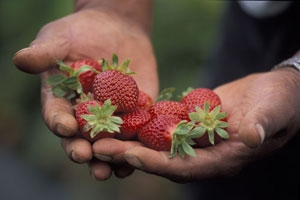Posts Tagged: strawberries
Survey identifies 19 produce candidates for a farm-to-WIC program
A new federal voucher that gives low-income women access to a range of fruits and vegetables could provide unique new marketing opportunities for California growers.
In 2009, the federal Special Supplemental Nutrition Program for Women, Infants and Children (WIC) began distributing monthly cash vouchers to low-income women with children to buy fruits and vegetables. The program reaches almost half of the infants and one-quarter of children under 5 years old in the United States.
A team of UC Cooperative Extension (UCCE) researchers and nutrition advisors has been exploring the possibility of developing a farm-to-WIC program that would link these low-income consumers with local growers. The purpose of such a program would be to increase the consumption of a wide variety of fresh produce, with a focus on locally grown produce when available.
UCCE conducted a survey of produce preferences and buying habits among WIC participants in Tulare, Alameda and Riverside counties in 2010. The full study is published in the January-March 2012 issue of California Agriculture journal.
Based on the results, the UCCE team developed a list of 19 produce items to promote in a possible new farm-to-WIC program. They are:
|
|
|
Although mustard greens and collards were not popular across all sites, the advisors gauged a potential market in Alameda County, so these were retained. Based on write-in responses, oranges were also added.
In California, which has the nation's largest WIC program, 82 local agencies serve about 1.43 million participants at 623 local centers, and WIC participants can redeem their monthly vouchers at 4,000 grocery stores statewide. About 40 percent shop at WIC-only stores, which stock and sell only WIC-authorized foods.
Stocking produce is relatively new to WIC-only stores; before rollout of new WIC food packages in October 2009, these stores were only required to stock limited amounts of fresh carrots. In the survey, most WIC participants (58 percent to 72.3 percent) responded that their preferred stores offered many choices, but fewer participants (18.5 percent to 41 percent) rated the produce quality as “excellent.” Key factors determining purchase decisions were produce quality and freshness, and nutrient value (vitamins and minerals). Cost was relatively less important, possibly because WIC participants procure the produce with the vouchers.
The list has served as a starting point for discussions with growers and WIC vendors.
“The survey showed that WIC participants were interested in purchasing fresh produce with better quality and more variety,” wrote lead author Lucia L. Kaiser, Cooperative Extension specialist in the UC Davis Department of Nutrition, and co-authors, in California Agriculture. “Some WIC participants that we surveyed said they avoided shopping at WIC-only stores in part because these interests were not met.”
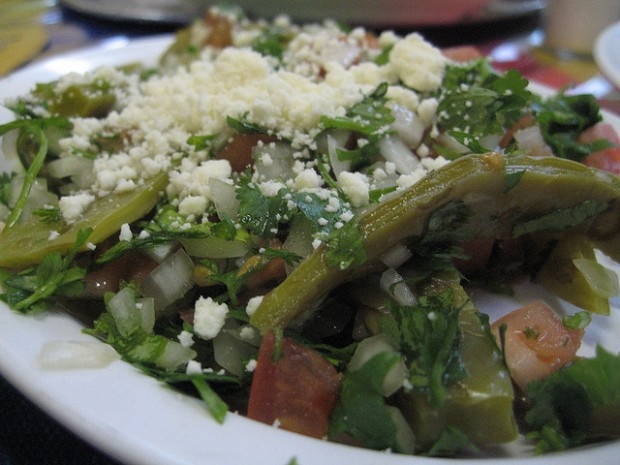
A dish made with nopales (cactus pads).
U-pick organic strawberry season opens on coast
The U-pick strawberry fields at Swanton Berry Farm near Davenport on the coast are formally opening on May 28, but if you drive out there now, you’ll get a chance to pick without a crowd. Talking to Barrett Boaen, the U-pick manager, I got to the bottom of just why their berries, also sold at local Whole Foods stores, look and taste so good.
Partly it’s the ‘Chandler’ variety, chosen for its old-fashioned sweetness and flavor although it yields only about two-thirds as well as some varieties. It’s also about not pumping up production with too much nitrogen or irrigation (more details here). Mostly, though, it’s about the picking process. A strawberry grower visiting from the East Coast recently bought two flats from the farmstand, saying he couldn’t help himself, he had never laid eyes on such beautiful organic berries, and he knew who to congratulate—the pickers.
You and I are unlikely to come close to picking as well as Swanton’s unionized employees, some of whom have more than 20 years of experience at the farm. They recognize when a strawberry is as ripe as it can be, when it’s red and sweet all the way through (strawberries don’t continue ripening once they are picked). Although a less ripe berry is firmer, with a longer shelf-life and easier to transport, it has less flavor, so the pickers wait a day or two for any berry with a green tip or white shoulders to ripen perfectly. They discard berries that are soft on one side (from raindrops settling on the fruit) or have a cat-face look, which is lygus bug damage.
Moving along the rows, which are banked up to 18 inches high to reduce back strain, they harvest each perfectly ripe berry, with its green calyx attached, in a “twist and flick” motion: “you put tension on the stem above the calyx, and rotate it, so you can see 360 degrees and whether there’s any damage to the berry; then with just the right tension, the berry will pop off naturally,” explains Boaen.
In the U-pick fields, which have ocean views, visitors pick for pleasure, hopping from row to row, enjoying the fresh air, and the fragrance of the berries and the earth. Compared to the serious work in the other 20 acres of strawberries, “the 3 acres of U-pick are a playground,” says Boaen, “We provide people everything they need to be happy.”
“It can be demoralizing,” Boaen admits. “All that energy put into the fruit after the excellent warm January was wrecked.”
Fortunately, the farm has several other crops, and the strawberry fields are filling with new berries. You can pick them this summer for $2.50 per pound (10 percent discount for bicyclists). Bring your own containers if you remember, a windproof jacket and boots in case of fog or mud, and most of all, Boaen recommends allowing plenty of time to enjoy yourself.
By mid-June, Swanton ollalieberries will be ripe, and by mid- or late July, the blackberries will be ready. Farm tours are available by reservation. Organic strawberry and ollalieberry jams, and five other kinds, are available at the farmstand or online.

Swanton's farmstand
Delicious, healthful strawberries will be available soon at valley roadside stands
Central Valley strawberry stands are expected to open soon, and if the next few weeks remain dry, as expected, it looks to be an excellent production year, report UC Cooperative Extension farm advisors in Fresno, Merced and Sacramento counties. One stand in Fresno opened on April 9, and others will begin selling this weekend.
Valley strawberry production is small compared to Southern California and Coastal production areas. Nearly all the farms are just a few acres in size and the bulk of their produce is sold at roadside stands. UC farm advisors work closely with these producers to help them grow safe and wholesome fruit.
The farmers are mainly Mien and Hmong refugees from Laos, a Southeast Asian country that neighbors Vietnam. When the U.S. left Southeast Asia in 1975, thousands of Hmong and Mien fled their homeland to avoid persecution. Over 120,000 were eventually resettled in the U.S. The population today has expanded to an estimated 300,000.
Many of the first-generation immigrants were farmers in Laos and turned to farming in the U.S. These growers lease small plots and grow several varieties of strawberries, such as Chandler, Camarosa, Albion and Seascape. Few have formal agricultural education.
In addition to offering production assistance, UC Cooperative Extension farm advisors Richard Molinar in Fresno, Maxwell Norton in Merced and Chuck Ingels in Sacramento offer food safety training to reduce the risk of a foodborne illness outbreak associated with strawberries. Working with the California Strawberry Commission, Molinar and Norton have for the last five years held intensive food safety workshops that included hands-on training about proper handling of the fruit and personal hygiene. The farmers were given training materials in Hmong and English that they could use to teach the workers they hired about reducing any chances of the fruit becoming contaminated. Twenty-six growers in the Fresno region and 27 in the Merced region participated in workshops. Many are currently learning about third-party food safety audits with the California Department of Food and Agriculture.
In Sacramento County, Ingels and a team of researchers provided on-farm training in pest management and food safety. Ingels’ team worked directly with 11 strawberry growers in 2009 and 2010.
“On the first visit to their farms, we found out their current practices and then provided training,” Ingels said. “We came back a second time to do further training and evaluate their progress. We visited the farms a third time to determine whether changes to their practices were being sustained. There was definitely a shift (for the better).”
With an increasing focus on food safety, many produce buyers, suppliers, and consumers want to know that good agricultural practices are being used on the farm. The programs in the various counties help to document and verify that farms are producing fruits and vegetables in the safest manner possible and that the farmer is aware of potential problems and steps to correct them.
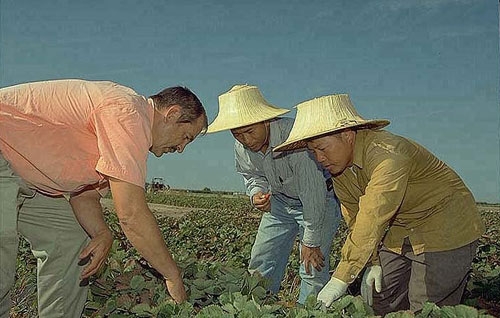
Richard Molinar, left, and his assistant Michael Yang, center, work with a Southeast Asian strawberry grower.
Organic strawberries may be more nutritious and longer lasting
While numerous studies have shown that organically grown foods contain fewer pesticide residues, there has been little convincing scientific evidence that organic crops taste better or are more nutritious.
Now a two-year evaluation of California strawberries has found that organic strawberries, while lower in phosphorus and potassium, had significantly higher “antioxidant activity and concentrations of ascorbic acid [vitamin C] and phenolic compounds, longer shelf life, greater dry matter, and for ‘Diamante’, better taste and appearance” than conventionally grown berries.
The study has been getting a lot of media attention, including coverage in the L.A. Times, Seattle Times and National Public Radio.
Published in the September 2010 issue of PLoS ONE, an open-access, peer-reviewed journal, the study looked at 13 pairs of commercial organic and conventional strawberry agroecosystems. The fields were all in the Watsonville area, where 40 percent of California strawberries are produced. All of the paired farms had been in production at least five years and had comparable soil types. The researchers collected multiple samples in 2004 and 2005, and evaluated the strawberries for minerals, shelf life and phytochemicals. A sensory panel compared the organoleptic properties of three different varieties of fruit.
Regarding post-harvest durability, the organic berries — despite no fungicide applications — had significantly less gray mold and significantly less loss of fresh weight two days after harvest than conventional berries.
“These results indicated that the organic strawberries have a longer shelf life than conventional strawberries because of slower rotting and dehydration, perhaps due to augmentation of cuticle and epidermal cell walls,” the authors wrote.
Mark Bolda, UC Cooperative Extension farm advisor for strawberries in Santa Cruz County, said there are a number of variables that could account for a reduction in gray mold infestation.
“For example, organic plants are smaller in size, have a smaller canopy and consequently are drier because of more air circulation,” Bolda said. “Flowers and fruit subsequently present a drier and less appealing host for this fungus.”
Not surprisingly, the study found that “soils on the organic farms had significantly more carbon and nitrogen, greater microbial biomass and function, and great functional gene abundance and diversity.” The authors attributed this to the fact that the conventional sites were fumigated with methyl bromide and treated with synthetic pesticides, while the organic sites were not and received double the amounts of compost.
The researchers were affiliated with Washington State University, Pullman; Utah State University, Logan; Oak Ridge National Laboratory, Oak Ridge, Tennessee; and University of Oklahoma, Norman.
U.S. consumers continue to clamor for organic foods, sales of which have increased nearly six-fold since 1997 to $21.8 billion in 2008 (3 percent of total U.S. food sales). California produces 87 percent of the nation’s strawberries, of which nearly 5 percent are organically grown.
It looks great, but does it taste great?
Taking a look at melons, berries, tomatoes, pears, stone fruit, and more, researchers from UC Davis, along with collaborators from the University of Florida, are focusing on increasing consumption of specialty crops by enhancing quality and safety. Funded by the USDA, work on this Specialty Crops Research Initiative (SCRI) grant began about a year ago.
Americans, after years of hearing that fresh produce is valuable for numerous health benefits, have still not significantly increased their consumption. So, why don’t we eat more fruits and vegetables? Researchers believe that the key reason is that the quality of produce is inconsistent – often with poor texture, flavor or aroma. It might look beautiful on the outside, but when you take a bite – Ugh! It just doesn’t match up to its attractive exterior.
Most produce found at the local market is harvested from the field or orchard before it is fully ripe, shipped a long distance, and then the ripening is completed at a regional produce distribution center or at the local market.
“Harvesting produce early reduces losses due to bruises, decay and other defects,” explained Beth Mitcham, SCRI Grant UCD project leader, “but oftentimes the product never reaches its potential, a full ripe flavor or aroma. Fresh produce, especially when harvested near full ripe stage, can be challenging to handle properly.”
The SCRI grant is an ambitious effort to understand what characteristics are critical for consumers to enjoy produce and develop better methods to measure flavor quality, then work with better tasting varietals and improved shipping and handling practices to allow economically viable delivery of truly delicious fruits and vegetables.
Consumer focus groups are being interviewed for their input, trained taste panels are enjoying a variety fresh produce, and experiments with pallet shrouds and other modified atmosphere transportation experiments are underway. Significant information has already been elicited from consumer groups. Through focus groups, the investigators have discovered that aroma and texture are nearly as important as sweetness, and shoppers get really irritated when produce looks good but tastes bad, and this keeps repeat purchases to a minimum.
Produce managers also have a tough time: set up displays of produce, keep it at the right temperature, watch people wandering around squeezing everything to see if their firmness requirements are met, meanwhile damaging the fruit. It’s a tough market for fresh fruit these days, with fewer consumers’ dollars allocated for produce purchases, but with the advances researchers are making through the SCRI project and others, sweet success is on the way.
Note: This topic was featured on a CBS13 (KOVR) News clip dated 7/17/10, see: http://www.cbs13.com/video/?id=76639@kovr.dayport.com



